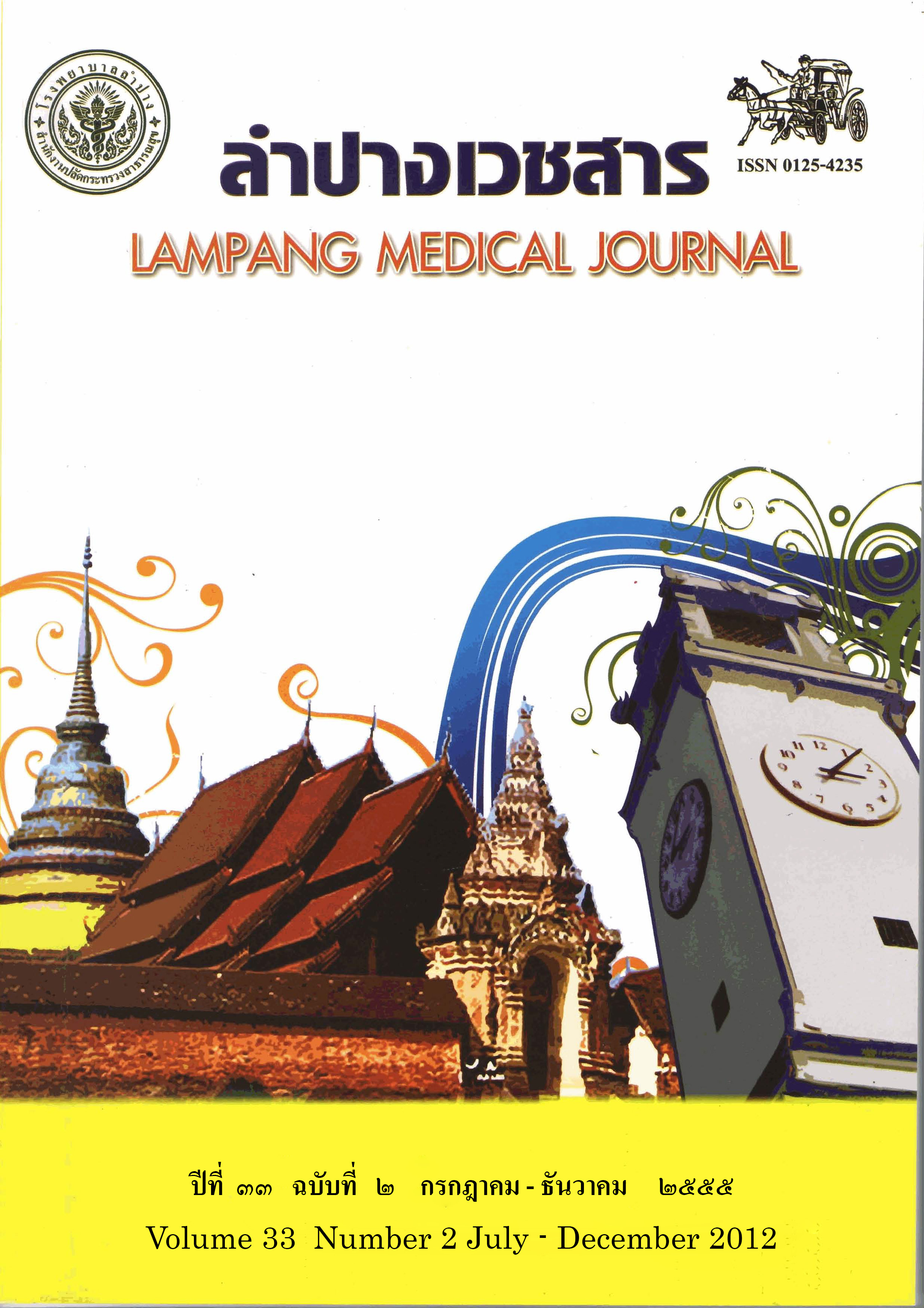Investigation and Control of Neonatal Omphalitis Outbreak in Lampang Hospital
Main Article Content
Abstract
Backgroud : Neonatal omphalitis is one of the leading causes of admission and neonatal death. Once in a decade, an omphalitis outbreak occurred in Lampang Hospital between June and July 2012.
Objective : To investigate, confirm diagnosis and explore the outbreak characteristics, including implement the prevention and control measures.
Material and method : A descriptive study was conducted among newborns with omphalitis in Lampang Hospital. Investigators observed and interviewed health personnel regarding to the processes from delivery to discharge. Environmental survey and bacterial testing were performed among the related wards.
Results : The outbreak involved 8 newborns, 62.5% was female. All of them underwent full-term delivery and three-fourth by caesarian section with the mean birth weight of 3,525 gm. The median incubation period was 3 days. All cases had erythema and serous drainage, 5 cases had purulence, with improvement after oral antibiotics for 3-5 days. The major causative
bacterial was Proteus mirabilis (75%) with similar antibiogram. Specimen cultures of the tank water, sinks and bathing equipment yielded multi-organisms that were not compatible with the causative agent. The residual chlorine level in pipe water was normal (0.5-1 ppm). Risk factors from hand cleansing, sterilization and storage of materials in operating room, labor room and wards were found.
Conclusion : The major causative organism of this neonatal omphalitis outbreak in Lampang Hospital was Proteus mirabilis and not compatible with those from the environment. After root cause analysis and implementing prevention and control measures, subsequent surveillance found no additional case.
Article Details

This work is licensed under a Creative Commons Attribution-NonCommercial-NoDerivatives 4.0 International License.
บทความที่ส่งมาลงพิมพ์ต้องไม่เคยพิมพ์หรือกำลังได้รับการพิจารณาตีพิมพ์ในวารสารอื่น เนื้อหาในบทความต้องเป็นผลงานของผู้นิพนธ์เอง ไม่ได้ลอกเลียนหรือตัดทอนจากบทความอื่น โดยไม่ได้รับอนุญาตหรือไม่ได้อ้างอิงอย่างเหมาะสม การแก้ไขหรือให้ข้อมูลเพิ่มเติมแก่กองบรรณาธิการ จะต้องเสร็จสิ้นเป็นที่เรียบร้อยก่อนจะได้รับพิจารณาตีพิมพ์ และบทความที่ตีพิมพ์แล้วเป็นสมบัติ ของลำปางเวชสาร
References
Gallagher GG, Shah SS. Omphalitis. Medscape Reference 2012 Jun. [cited 17 September 2012] Available from: http://emedicine.medscape.com/article/975422-overview
ศิริภัทร เกียรติพันธุ์สดใส. ความผิดปกติของสะดือในทารกและเด็ก. [เข้าถึงเมื่อ 17 กันยายน 2555] เข้าถึงได้จาก: http://www.med.tu.ac.th/UserFiles/File/Data%20microsite/Clinic/Research/13%20bkv13.pdf
Martin R. Fanaroff and Martin’s neonatal-perinatal medicine: disease of the fetus and infant. 8th ed. Philadelphia: Mosby Elsevier; 2006.
Panyavudhikrai S, Danchaivijitr S, Vantanasiri C, Trakulsomboon S, Kolatat T, Dhiraputra C, et al. Antiseptics for preventing omphalitis. J Med Assoc Thai 2002;85(2): 229-34.
Fraser N, Davies BW, Cusack J. Neonatal omphalitis: a review of its serious complications. Acta Paediatr 2006;95(5):519-22.
Chowdhury MN, Kambal AM. An outbreak of infection due to Staphylococcus aureus phage type 52 in a neonatal intensive care unit. J Hosp Infect 1992;22(4):299-305.
Holgate S. Infection outbreaks in a neonatal nursery 2008. [cited 17 September 2012] Available from: http://www.slideserve.com/abril/infection-outbreaks-in-a-neonatal-nursery
Nelson JD, Dillon HC Jr, Howard JB. A prolonged nursery epidemic associated with a newly recognized type of group A streptococcus. J Pediatr 1976;89(5):792-6.
Zafar AB, Butler RC, Reese DJ, Gaydos LA, Mennonna PA. Use of 0.3% triclosan (Bacti-Stat) to eradicate an outbreak of methicillin-resistant Staphylococcus aureus in a neonatal nursery. Am J Infect Control 1995;23(3):200-8.
Centers for Disease Control and Prevention, National Healthcare Safety Network. CDC/NHSN surveillance definition of healthcare-associated infection and criteria for specific types of infections in the acute care setting. [cited 17 September 2012]. Available from: http://
www.cdc.gov/nhsn/pdfs/pscmanual/17pscnosinfdef_current.pdf
Güvenç H, Aygün AD, Yasar F, Soylu F, Güvenç M, Kocabay K. Omphalitis in term and preterm appropriate for gestational age and small for gestational age infants. J Trop Pediatr 1997;43(6):368–72.
Sawardekar KP. Changing spectrum of neonatal omphalitis. Pediatr Infect Dis J 2004; 23(1):22–6.
Struble K, Bronze MS, Jackson RL, Gonzalez G. Proteus infections. Medscape Reference 2011 Aug. [cited 29 September 2012]; Available from: http://emedicine.medscape.com/article/226434-overview
Airede AI. Pathogens in neonatal omphalitis. J Trop Pediatr 1992;38(3):129-31. 15. Brook I. Microbiology of necrotizing fasciitis associated with omphalitis in the newborn infant. J Perinatol 1998;18(1):28-30.
Mullany LC, Darmstadt GL, Katz J, Khatry SK, LeClerq SC, Adhikari RK, et al. Risk factors for umbilical cord infection among newborns of southern Nepal. Am J Epidemiol 2007; 165(2):203–211.
Soofi S, Cousens S, Imdad A, Bhutto N, Ali N, Bhutta ZA. Topical application of chlorhexidine to neonatal umbilical cords for prevention of omphalitis and neonatal mortality in a rural district of Pakistan: a community-based, cluster-randomised trial. Lancet 2012;379:1029–36.


